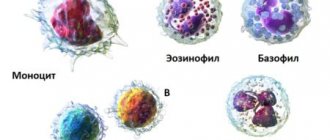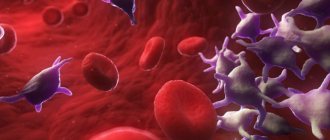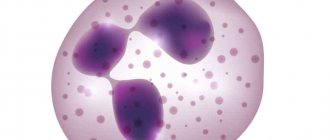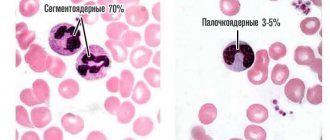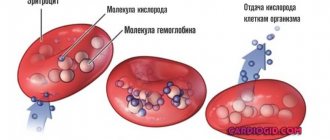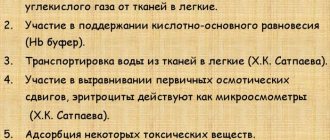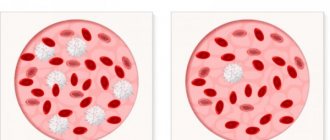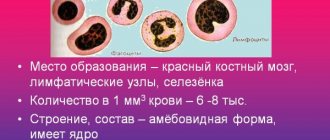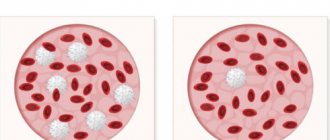What are red blood cells?
Red blood cells play an important role in the human body. Their main task is to supply oxygen, which is supplied during breathing to all tissues and organs of our body. The carbon dioxide formed in this situation must be urgently removed from the body, and here the red blood cell is the main assistant. By the way, these blood cells also enrich our body with nutrients. Red blood cells contain a well-known red pigment called hemoglobin. It is he who is able to bind oxygen in the lungs for more convenient removal, and release it in the tissues. Of course, like any other indicator in the human body, the number of red blood cells can decrease or increase. And there are reasons for this:
- an increase in the number of blood cells in the blood indicates severe dehydration or chronic leukemia (erythremia);
- a decrease in this indicator will indicate anemia (this is not a disease, but this blood condition can contribute to the development of a large number of other diseases);
- By the way, oddly enough, red blood cells are often detected in the urine of patients who complain of problems with the urinary system (bladder, kidneys, etc.).
A very interesting fact: the size of a red blood cell can sometimes change significantly, this happens due to the elasticity of these cells. For example, the diameter of a capillary through which a red blood cell measuring 8 microns can pass is only 2-3 microns.
erythrocytes, properties and functions.
E R I T R O C I T
(Greek erythoros - red, cytus - cell) - a nuclear-free blood element containing hemoglobin. It has the shape of a biconcave disk with a diameter of 7-8 microns, a thickness of 1-2.5 microns. They are very flexible and elastic, easily deformed and pass through blood capillaries with a diameter smaller than the diameter of a red blood cell. They are formed in the red bone marrow and destroyed in the liver and spleen. The lifespan of red blood cells is 100-120 days. In the initial phases of their development, red blood cells have a nucleus and are called reticulocytes. As it matures, the nucleus is replaced by respiratory pigment - hemoglobin, which makes up 90% of the dry matter of erythrocytes.
Normally, the blood level in men is 4 – 5 1012 /l, in women 3.7 – 5 1012 /l, in newborns up to 6 1012 /l. An increase in the number of red blood cells per unit volume of blood is called erythrocytosis (polyglobulia, polycythemia), a decrease is called erythropenia. The total surface area of all red blood cells in an adult is 3000-3800 m2, which is 1500-1900 times the surface of the body.
Functions of red blood cells:
1) respiratory - due to hemoglobin, which attaches O2 and CO2;
2) nutritional – adsorbing amino acids on its surface and delivering them to the cells of the body;
3) protective – binding of toxins by antitoxins located on their surface and participation in blood clotting;
4) enzymatic – transfer of various enzymes: carbonic anhydrase (carbonic anhydrase), true cholinesterase, etc.;
5) buffer – maintaining blood pH in the range of 7.36-7.42 with the help of hemoglobin;
6) creative – transport substances that carry out intercellular interactions, ensuring the preservation of the structure of organs and tissues. For example, when the liver is damaged in animals, red blood cells begin to transport nucleotides, peptides, and amino acids from the bone marrow to the liver, restoring the structure of this organ.
Hemoglobin is the main component of red blood cells and provides:
1) respiratory function of the blood due to the transfer of O2 from the lungs to the tissues and CO2 from the cells to the lungs;
2) regulation of the active reaction (pH) of the blood, having the properties of weak acids (75% of the buffer capacity of the blood).
According to its chemical structure, hemoglobin is a complex protein - a chromoprotein, consisting of the globin protein and the prosthetic group heme (four molecules). Heme contains an iron atom that can attach and release an oxygen molecule. In this case, the valence of iron does not change, i.e. it remains divalent.
Normally, human blood should ideally contain 166.7 g/l of hemoglobin. In men, on average, the normal hemoglobin content is 130-160 g/l, in women 120-140 g/l. A decrease in hemoglobin content in the blood is anemia; the color indicator is the degree of saturation of red blood cells with hemoglobin. Normally it is 0.86-1. A decrease in the color index usually occurs with iron deficiency in the body - iron deficiency anemia, an increase above 1.0 - with a deficiency of vitamin B12 and folic acid. 1 g of hemoglobin binds 1.34 ml of oxygen. The difference in the content of red blood cells and hemoglobin in men and women is explained by the stimulating effect of male sex hormones on hematopoiesis and the inhibitory effect of female sex hormones. Hemoglobin is synthesized by erythroblasts and normoblasts of the bone marrow. When red blood cells are destroyed, hemoglobin, after heme is separated, is converted into bile pigment - bilirubin. The latter enters the intestine with bile, where it is converted into stercobilin and urobilin, excreted in feces and urine. During the day, about 8 g of hemoglobin is destroyed and converted into bile pigments, i.e. about 1% of hemoglobin found in the blood.
Skeletal muscle and myocardium contain muscle hemoglobin, called myoglobin. Its prosthetic group, heme, is identical to the same group of the hemoglobin molecule in the blood, and the protein part, globin, has a lower molecular weight than the hemoglobin protein. Myoglobin binds up to 14% of the total amount of oxygen in the body. Its purpose is to supply oxygen to the working muscle at the moment of contraction, when the blood flow in it decreases or stops.
Normally, hemoglobin is contained in the blood in the form of three physiological compounds:
1) oxyhemoglobin (HbO2) – hemoglobin that has added O2; is found in arterial blood, giving it a bright scarlet color;
2) reduced, or reduced, hemoglobin, deoxyhemoglobin (Hb) - oxyhemoglobin that has given up O2; found in venous blood, which is darker in color than arterial blood;
3) carbhemoglobin (HbСO2) – a compound of hemoglobin with carbon dioxide; found in venous blood.
Hemoglobin is also capable of forming pathological compounds.
The affinity of iron hemoglobin for carbon monoxide exceeds its affinity for O2, so even 0.1% carbon monoxide in the air leads to the conversion of 80% of hemoglobin into carboxyhemoglobin, which is unable to attach O2; which is life-threatening. Mild carbon monoxide poisoning is a reversible process. Inhaling pure oxygen increases the rate of breakdown of carboxyhemoglobin by 20 times.
Methemoglobin (MetHb) is a compound in which, under the influence of strong oxidizing agents (aniline, Bertholet salt, phenacetin, etc.), heme iron is converted from divalent to trivalent. When a large amount of methemoglobin accumulates in the blood, oxygen transport to tissues is disrupted, and death can occur.
L E Y K O C I T
(Greek leukos - white, cytus - cell), or white blood cell is a colorless nuclear cell that does not contain hemoglobin. The size of leukocytes is 8-20 microns. They are formed in the red bone marrow, lymph nodes, spleen, and lymphatic follicles. 1 liter of blood normally contains 4 – 9 109 leukocytes /l. An increase in the number of leukocytes in the blood is called leukocytosis, a decrease is called leukopenia. The lifespan of leukocytes is on average 15-20 days, lymphocytes - 20 years or more. Some lymphocytes live throughout a person's life.
Leukocytes are divided into two groups: granulocytes (granular) and agranulocytes (non-granular). The granulocyte group includes neutrophils, eosinophils and basophils, and the agranulocyte group includes lymphocytes and monocytes. When assessing changes in the number of leukocytes in the clinic, decisive importance is attached not so much to changes in their number, but to changes in the relationships between different types of cells. The percentage of individual forms of leukocytes in the blood is called the leukocyte formula, or leukogram.
Functions of red blood cells
It would seem that a small red blood cell can do anything useful in such a large human body. But the size of the red blood cell does not matter here. It is important that these cells perform vital functions:
- Protect the body from toxins: bind them for subsequent removal. This happens due to the presence of protein substances on the surface of red blood cells.
- They carry enzymes, called specific protein catalysts in the medical literature, to cells and tissues.
- They are responsible for human breathing. This occurs due to the content of hemoglobin in the erythrocyte (it is capable of attaching and releasing oxygen, as well as carbon dioxide).
- Red blood cells nourish the body with amino acids, which they easily transport from the gastrointestinal tract to cells and tissues.
Red blood cell composition
- About a third of the red blood cell consists of hemoglobin.
- It also contains a complex compound that consists of globin protein and heme ferrous iron.
- Hemoglobin is found in red blood cells and is not found in a free state in the blood of healthy people.
- A red blood cell contains about two hundred to three hundred hemoglobin molecules. Due to its structure, hemoglobin is an ideal transport vehicle for gases.
In the capillaries of the lungs, oxygen molecules attach to hemoglobin, causing the red blood cell to turn bright red. Having given oxygen to the cells, hemoglobin attaches carbon dioxide molecules. At the same time, it changes its color to dark red.
Place of formation of red blood cells
It is important to know where red blood cells are formed so that if problems arise with their concentration in the blood, you can take timely measures. The process of creating them is complex.
The place of formation of red blood cells is the bone marrow, spine and ribs. Let's take a closer look at the first of them: first, brain tissue grows due to cell division. Later, from the cells that are responsible for creating the entire human circulatory system, one large red body is formed, which has a nucleus and hemoglobin. From it the precursor of the red blood cell (reticulocyte) is directly obtained, which, upon entering the blood, is transformed into an erythrocyte in 2-3 hours.
How are blood cells formed?
Erythropoiesis (the process of synthesis of red cells) occurs in the bone marrow of flat bones (skull, spine and ribs). In childhood, the source of red blood cells is the tubular bones of the arms and legs. Their lifespan is about 3 months. After this, the cells die in the liver and spleen.
There are different types of red blood cells. Before entering the bloodstream, cells go through several stages of development. The ancestors of red blood cells are universal stem cells. After several divisions they lose their versatility and become pluripotent. Various blood particles can form from them. After a few more divisions, the cells acquire specificity (unipotent cells). At the last stages of the formation of young red blood cells, hemoglobin synthesis begins and the nucleus is removed. The entire process of body formation takes 1 or 2 days.
Young cells leave the site of red blood cell formation and enter the blood vessels. At this stage of their development they are called reticulocytes. They no longer have a nucleus, but still contain remnants of ribonucleic acids. They are pink in color with blue spots.
Reticulocytes make up 1% of all red blood cells circulating in the bloodstream. After 1-3 days, young cells mature and turn into mature ones. The number of reticulocytes characterizes the regenerative function of the bone marrow. The reticulocyte count is designated RTC.
The process of erythropoiesis is controlled by the hormone erythropoietin, which is produced by the kidneys. In case of increased hormone synthesis, the production of corpuscles increases.
The number of RBCs in a blood test depends on vitamin B12. It is a catalyst for erythropoiesis. With a lack of vitamin B12, impaired cell maturation occurs.
Folic acid also has a huge impact on the process of hematopoiesis. It takes part in the synthesis of purine and pyrimidine nucleotides as a coenzyme (a substance necessary for the functioning of the enzyme).
Structure of a red blood cell
Since red blood cells contain large amounts of hemoglobin, this causes their bright red color. In this case, the cell has a biconcave shape. The structure of erythrocytes of immature cells requires the presence of a nucleus, which cannot be said about the finally formed body. The diameter of red blood cells is 7-8 microns, and the thickness is less - 2-2.5 microns. The fact that mature red blood cells no longer have a nucleus allows oxygen to penetrate into them faster. The total number of red blood cells found in human blood is very large. If they are folded into one line, then its length will be about 150 thousand km. Various terms are used for red blood cells to characterize deviations in their size, color and other characteristics:
- normocytosis - normal average size;
- microcytosis - size smaller than normal;
- macrocytosis - size larger than normal;
- anitocytosis - in this case, the size of the cells varies significantly, i.e. some of them are too large, others are too small;
- hypochromia - when the amount of hemoglobin in red blood cells is less than normal;
- poikilocytosis - the shape of the cells is significantly changed, some of them are oval, others are sickle-shaped;
- normochromia - the amount of hemoglobin in the cells is normal, which is why they are colored correctly.
About hemoglobin
Without this substance, the main function of red blood cells in the body would not be realized. The fact is that hemoglobin is the main carrier of oxygen. This gas can also reach the cells with the flow of plasma, but in this liquid it is found in very small quantities.
The structure of hemoglobin is quite complex. It contains two compounds: heme and globin. The structure of heme contains iron. It is necessary for effective oxygen binding. Moreover, it is this metal that gives blood its characteristic red color.
How does a red blood cell live?
From the above, we have already found out that the place of formation of red blood cells is the bone marrow of the skull, ribs and spine. But once in the blood, how long do these cells stay there? Scientists have found that the life of a red blood cell is quite short - on average about 120 days (4 months). By this time he begins to age for two reasons. This is the metabolism (breakdown) of glucose and an increase in the content of fatty acids. The red blood cell begins to lose energy and elasticity of the membrane, because of this, numerous outgrowths appear on it. Most often, red blood cells are destroyed inside the blood vessels or in some organs (liver, spleen, bone marrow). Compounds formed as a result of the breakdown of red blood cells are easily excreted from the human body through urine and feces.
Red blood cell count: tests to determine their level
In principle, in medicine there are only two types of tests through which red blood cells are detected: blood and urine tests.
The latter of them less often shows the presence of red cells, and often this is due precisely to the presence of some kind of pathology. But human blood always contains red blood cells, and it is important to know the norms of this indicator. The distribution of red blood cells in the blood of an absolutely healthy person is even, and their content is quite high. That is, if he had the opportunity to count their entire number, he would get a huge number that does not carry any information. Therefore, in the course of laboratory research, it is customary to use the following method: count red blood cells in a certain volume (1 cubic millimeter of blood). By the way, this value will allow you to correctly assess the level of red blood cells and identify existing pathologies or health problems. It is important that it is particularly influenced by the patient’s place of residence, his gender and age.
What are red blood cells?
Many people know “in general terms” what red blood cells are. And, although all people are repeatedly faced with the need for blood tests throughout their lives, it is difficult for them to decipher test results without special education.
Red blood cells are called erythrocytes, which are produced in the body and play an important role in hematopoiesis. Their share in the total number of all cells of the human body reaches 25%. Their function is to ensure cellular respiration, transport oxygen to organs and tissues from the lungs and take carbon dioxide from them. Red blood cells are the basis of tissue gas exchange. The number of red blood cells is huge, here are some data:
- if you combine all the red blood cells into one, then the total surface of this cell will occupy an area of 3800 square meters (a square with a side of 61.5 meters). It is this surface that is involved in gas exchange in our body every second - 1500 times more than the surface area of the human body;
- One cubic millimeter of blood contains 5 million red blood cells, and one cubic centimeter contains 5 billion, almost the same number of people living on our planet;
- If you put all the red blood cells of one person in a column, one on top of the other, it will cover a distance of more than 60,000 kilometers - 1/6 of the distance to the Moon.
The name of blood particles is derived from 2 words of Greek origin: erythros (red) and kytos (receptacle). Although they are called red cells, they are not always that color. At the ripening stage, they are colored blue because they contain little iron. Later the blood cells turn grey. When hemoglobin begins to predominate in them, they turn pink. Mature red blood cells are normally red. The dry matter of a mature erythrocyte contains 95% hemoglobin, and the remaining substances (proteins and lipids) account for no more than 4% of the volume. After oxygen is transferred to cells and tissues, the bodies enter the venous blood, changing their color to dark.
Mature human red blood cells are plastic, anucleate cells. Young red blood cells - reticulocytes - have a nucleus, but then they are freed from it in order to use the released volume to improve their function - gas exchange. This indicates how highly specialized erythrocytes are. So, they have the shape of a biconcave flexible lens. This shape allows you to increase their area, and at the same time reduce the volume of a relatively simple disk.
Their diameter ranges from 7.2-7.5 microns. The thickness of the cells is 2.5 microns (in the center no more than 1 microns), and the volume is 90 cubic microns. Outwardly, they resemble a flat cake with thick edges. Bodies can penetrate the thinnest capillaries, thanks to their ability to twist into a spiral.
The flexibility of red blood cells may change. The red blood cell membrane is surrounded by proteins that affect the properties of the blood cell. They can cause cells to stick together in columns or cause them to tear apart.
Every second, red blood cells are released into the blood in huge quantities. The volume of blood cells formed per day weighs 140 g. Approximately the same number of cells die. In a healthy person, the number of red blood cells in the blood changes slightly.
The number of red cells in women is less than in men. Therefore, men cope better with heavy physical activity. To ensure muscle function, tissues require a lot of oxygen.
The number of red blood cells is indicated by the RBC indicator in a blood test. It stands for Red Blood Cells.
Norms of red blood cells
A healthy person rarely experiences any deviations in this indicator throughout his life.
So, there are the following norms for children:
- the first 24 hours of a baby’s life – 4.3-7.6 million/1 cubic meter. mm blood;
- first month of life – 3.8-5.6 million/1 cubic meter. mm blood;
- the first 6 months of a child’s life – 3.5-4.8 million/1 cubic meter. mm blood;
- during the 1st year of life – 3.6-4.9 million/1 cubic meter. mm blood;
- 1 year - 12 years - 3.5–4.7 million/1 cubic meter. mm blood;
- after 13 years – 3.6-5.1 million/1 cubic meter. mm of blood.
The large number of red blood cells in the baby’s blood is easy to explain. When he is in his mother’s womb, his formation of red blood cells occurs at an accelerated rate, because this is the only way all his cells and tissues can receive the required amount of oxygen and nutrients for their growth and development. When a baby is born, red blood cells begin to rapidly break down, and their concentration in the blood decreases (if this process is too fast, the baby develops jaundice).
Norms of red blood cell content in the blood for adults:
- Men: 4.5-5.5 million/1 cubic meter. mm of blood.
- Women: 3.7-4.7 million/1 cubic meter. mm of blood.
- Elderly people: less than 4 million/1 cubic meter. mm of blood.
Of course, a deviation from the norm may be associated with some problem in the human body, but here consultation with a specialist is definitely necessary.
Types of erythropenia
A decrease in the number of red blood cells in the blood below established norms is called erythropenia.
It comes in 2 types:
- Relative. The number of red blood cells decreases in the tested blood due to the entry of a large amount of fluid into the body. This leads to blood thinning. But in the total volume of all blood, the level of red blood cells remains unchanged.
- Absolute – characterized by a low level of red blood cells in the blood. This indicates a violation of the blood formation process.
Red blood cells in urine - can this situation arise?
Yes, the doctors’ answer is definitely positive. Of course, in rare cases this may occur due to the fact that the person was carrying a heavy load or was in an upright position for a long time. But often an increased concentration of red blood cells in the urine indicates the presence of problems and requires consultation with a competent specialist. Remember some of its norms in this substance:
- the normal value should be 0-2 pcs. in sight;
- when a urine test is carried out using the Nechiporenko method, there can be more than a thousand red blood cells in the laboratory technician’s field of view;
If a patient has such urine tests, the doctor will look for the specific reason for the appearance of red blood cells in it, allowing for the following options:
- if we are talking about children, then pyelonephritis, cystitis, glomerulonephritis are considered;
- urethritis (the presence of other symptoms is also taken into account: pain in the lower abdomen, painful urination, increased body temperature);
- urolithiasis: the patient simultaneously complains of blood in the urine and attacks of renal colic;
- glomerulonephritis, pyelonephritis (lower back pain and temperature rises);
- kidney tumors;
- prostate adenoma.
Changes in the number of red blood cells in the blood: reasons
The structure of red blood cells presupposes the presence in them of a large amount of hemoglobin, which means a substance capable of absorbing oxygen and removing carbon dioxide.
Therefore, deviations from the norm characterizing the number of red blood cells in the blood can be dangerous to your health. An increase in the level of red blood cells in a person's blood (erythrocytosis) is not observed often and can be associated with some simple reasons: stress, excessive exercise, dehydration, or living in a mountainous area. But if this is not the case, pay attention to the following diseases that cause an increase in this indicator:
- Blood problems, including erythremia. Usually a person has a red coloration of the skin of the neck and face.
- Development of pathologies in the lungs and cardiovascular system.
A decrease in the number of red blood cells, medically called erythropenia, can also be caused by several reasons. First of all, it is anemia, or anemia. It may be associated with impaired formation of red blood cells in the bone marrow. When a person loses a certain amount of blood or red blood cells are destroyed too quickly in his blood, this situation also arises. Doctors often diagnose patients with iron deficiency anemia. Iron may simply not enter the human body in sufficient quantities or be poorly absorbed by it. Most often, to correct the situation, experts prescribe vitamin B12 and folic acid to patients along with iron-containing medications.
Treatment
Erythrocytopenia can be eliminated using conservative therapeutic methods, but to fully get rid of this problem it is necessary to eliminate the pathological etiological factor.
Regardless of the reason, you can increase your red blood cell count by:
- taking medications – often these are vitamin and mineral complexes;
- blood transfusion;
- adherence to a therapeutic diet;
- use of traditional medicine recipes.
People with a low red blood cell count are advised to enrich the menu:
- legumes;
- fatty fish;
- seafood;
- lentils and buckwheat;
- fresh vegetables;
- dried fruits;
- egg yolks;
- offal;
- green tea and cocoa;
- red meats;
- nuts and pumpkin seeds.
Unconventional treatment involves preparing medicinal drinks at home based on:
- lungworts;
- burnet roots;
- rosehip;
- strawberry or blackberry leaves;
- wheat grains;
- red clover;
- nettle;
- St. John's wort;
- chokeberry berries.
Particular attention to the choice of treatment tactics is given in cases of a decrease in red blood cells in the blood during pregnancy and in children.
ESR indicator: what does it mean?
Often, a doctor, having seen a patient who complains of some kind of cold (which has not gone away for a long time), prescribes a general blood test.
In it, often on the very last line you will see an interesting indicator of red blood cells, characterizing their sedimentation rate (ESR). How can such research be carried out in a laboratory? It’s very easy: the patient’s blood is placed in a thin glass tube and left in an upright position for a while. Red blood cells will certainly settle to the bottom, leaving clear plasma in the upper layer of blood. The unit of measurement for erythrocyte sedimentation rate is mm/hour. This indicator may vary depending on gender and age, for example:
- children: 1-month-old babies – 4-8 mm/hour; 6 months – 4-10 mm/hour; 1 year-12 years – 4-12 mm/hour;
- men: 1-10 mm/hour;
- women: 2-15 mm/hour; pregnant women - 45 mm/hour.
How informative is this indicator? Of course, recently doctors have begun to pay less and less attention to him. It is believed that there are many errors in it, which can be associated, for example, in children, with an excited state (screaming, crying) during blood collection. But in general, an increased erythrocyte sedimentation rate is the result of an inflammatory process developing in your body (say, bronchitis, pneumonia, any other cold or infectious disease). Also, an increase in ESR is observed during pregnancy, menstruation, chronic pathologies or diseases that a person has, as well as injuries, stroke, heart attack, etc. Of course, a decrease in ESR is observed much less frequently and already indicates the presence of more serious problems: leukemia, hepatitis, hyperbilirubinemia, and others.
As we have found out, the place of formation of red blood cells is the bone marrow, ribs and spine. Therefore, if there are problems with the number of red blood cells in the blood, you should first pay attention to the first of them. Every person needs to clearly understand that all the indicators in the tests that we take are very important for our body, and it is better not to treat them negligently. Therefore, if you have completed such a study, please contact a competent specialist to decipher it. This does not mean that at the slightest deviation from the norm in the analysis you should immediately panic. Just follow through, especially when it comes to your health.
Norms and deviations
The main indicators of red cells are assessed during a general blood test. This study shows the concentration of red blood cells, that is, the number in a certain part of the biomaterial, features of their shape, and hemoglobin level. Also during the procedure, various erythrocyte indices are determined, which make it possible to determine many other characteristics of erythrocytes necessary for making a diagnosis.
Quantity
The level of red blood cells in the blood of people of different ages and genders tends to differ slightly, which is considered as the norm if it does not leave the boundaries of generally accepted values. The unit of measurement for the content of the described cells is the number of cells per microliter (millions/µl or 1012/µl).
Reference! The norm of red blood cells in the blood of adult men varies in the range of 3.9-5.5 * 1012 / μl, while in women the upper limit of this indicator is slightly lower and amounts to 3.9-4.7 * 1012 / μl.
In children, the content varies depending on age characteristics. Thus, the normal level in umbilical cord blood is 3.9-5.5 * 1012/μl (3-51% accounts for reticulocytes). By the end of the first week of a newborn’s life, 3.9-6.3*1012/μl, in the second week – 3.9-6.2*1012/μl. In a healthy baby up to 1 month - 3.0-6.2 * 1012 / μl, in a two-month old - 2.7-4.9 * 1012 / μl. In a six-month-old child – 3.1-4.5*1012/µl (reticulocytes before this time decrease to 3-15%).
In children under 12 years of age, regardless of gender, the coefficient should be within the range of 3.5-5.0 (reticulocytes 3-12%). As they grow older, the indicators begin to vary slightly, which is directly related to the gender characteristics of adolescents.
So, for girls 13-19 years old, the normal parameters are 3.5-5.0*1012/µl, while for boys 13-16 years old they are 4.1-5.5*1012/µl, and for 16-19 years old - 3.9-5.6. Reticulocytes in both sexes at this age are still declining and should not exceed 2-11%. In elderly and old people, there is a slight decrease in indicators compared to middle-aged patients, and they decrease to 4.0.
It is worth mentioning one more group that has separate norms - pregnant women. When a woman is pregnant, the volume of circulating blood increases, but the number of formed particles (erythrocytes, leukocytes, platelets) remains unchanged.
As a result, a blood test shows an artificial decrease in the concentration of red cells in the volume of the biomaterial being studied. Therefore, for pregnant women, values of 3.6-5.6 * 1012 / μl are considered normal (the reticulocyte level for all adults should not exceed 1%).
Reference values of red blood cells in children of different ages
Promotion
In various situations, red blood cells in a person’s blood can change their number, and the reasons that led to these conditions can be both physiological and pathological. For example, in the first case, excess values are observed when living in mountainous areas, where the air is thin and people need more oxygen.
And since red blood cells are responsible for its transportation, the bone marrow increases their synthesis. The same applies to airplane pilots and mountain climbers. When the body is dehydrated, the values also increase.
Although, in any case, if blood tests show that the values of red cells in the sample are too high (scientifically called erythrocytosis), you should definitely find out whether any disease has led to this condition. This should not be delayed because excess red blood cells make the blood thicker, which can lead to blood clots.
Associated signs of erythrocytosis are usually nosebleeds, headaches, redness of areas of the body, etc. Red cell levels above normal are observed in chronic respiratory diseases - bronchitis, asthma, as well as heart defects.
Less common causes are neoplasms in the kidneys or endocrine glands. Sometimes an increase in values indicates an excess of steroid hormones, which can be prescribed for certain diseases.
Reference! There is a disease - erythremia (Vasquez disease, polycythemia vera), which can greatly increase the level of red blood cells in the blood.
This is an extremely rare (about 1 case per 60-80 thousand people) hereditary pathology, its course is identical to blood cancer, since the bone marrow begins to produce too many red blood cells. Most often, erythremia occurs in old age. The disease does not pose a direct threat to the patient’s life, and if all doctor’s instructions are followed, the person can live quite a long time.


